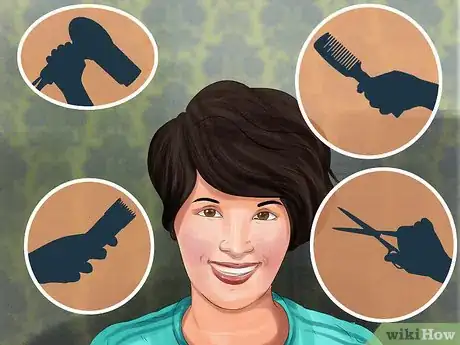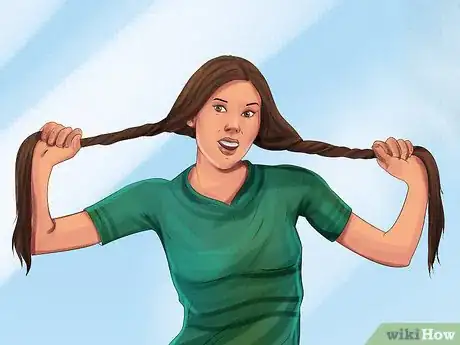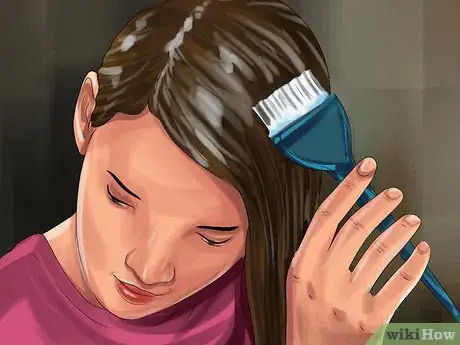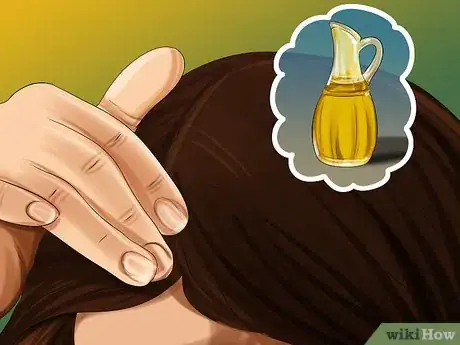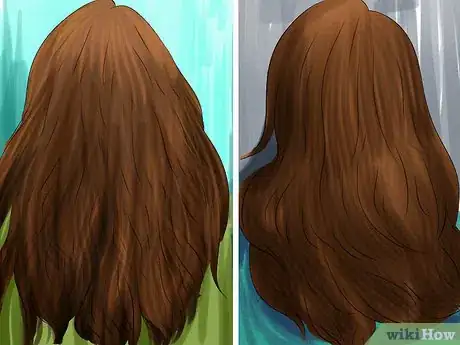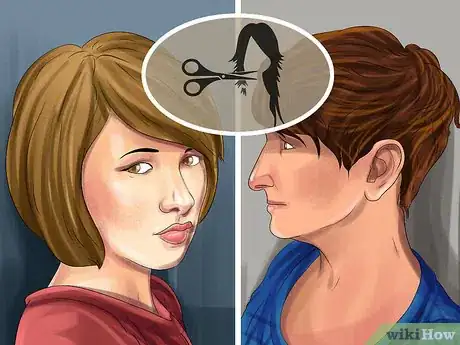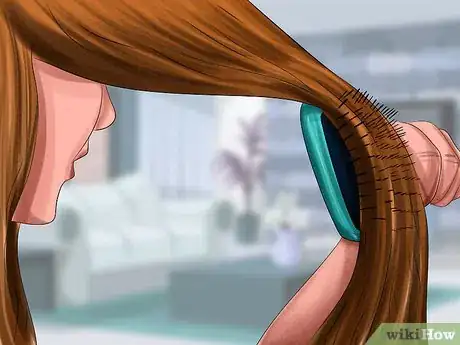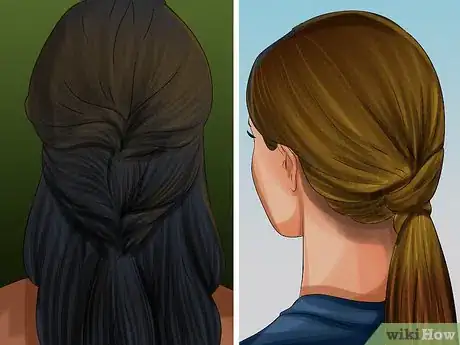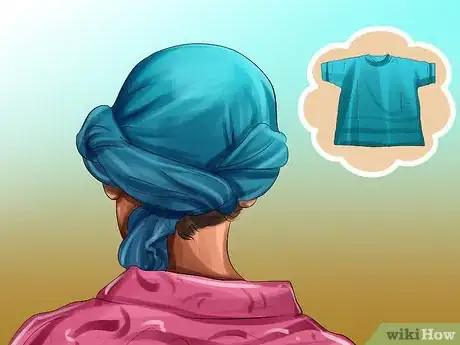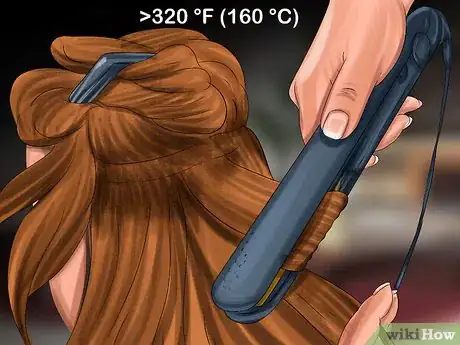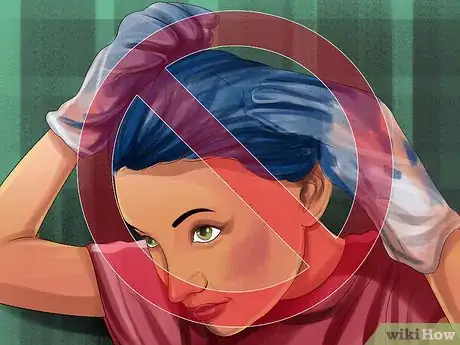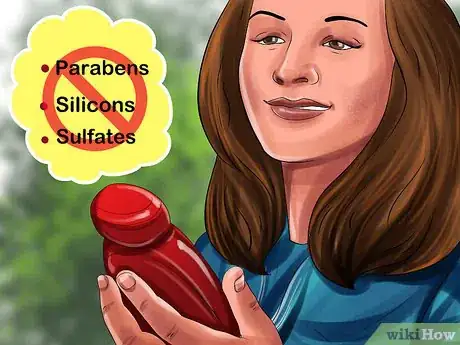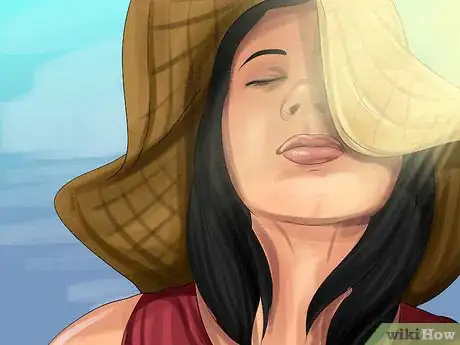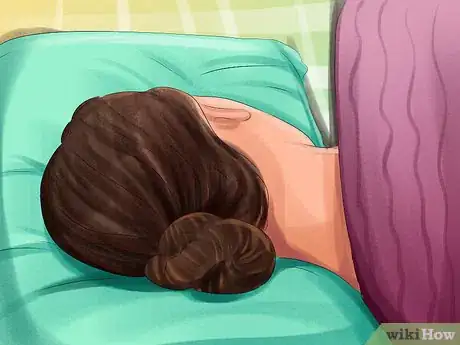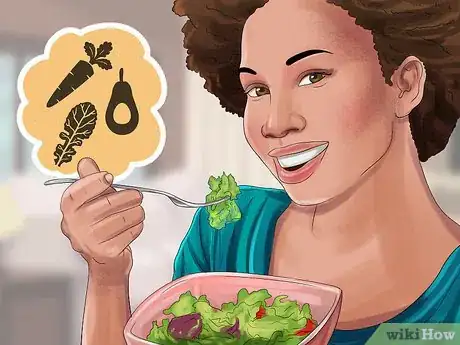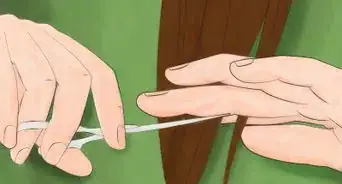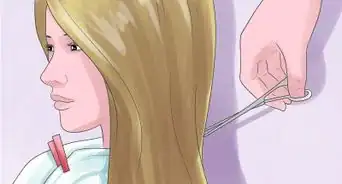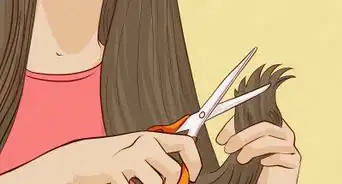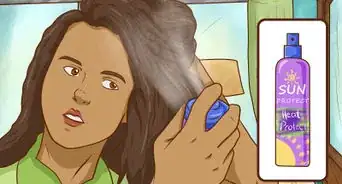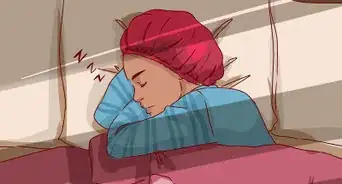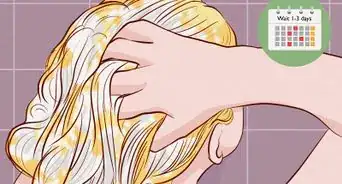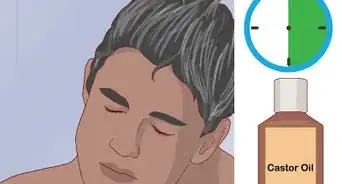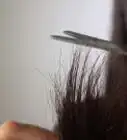This article was co-authored by Christine George. Christine George is a Master Hairstylist, Colorist, and Owner of Luxe Parlour, a premier boutique salon based in the Los Angeles, California area. Christine has over 23 years of hair styling and coloring experience. She specializes in customized haircuts, premium color services, balayage expertise, classic highlights, and color correction. She received her cosmetology degree from the Newberry School of Beauty.
There are 8 references cited in this article, which can be found at the bottom of the page.
This article has been viewed 59,058 times.
Heat damaged hair often looks dull and feels coarse to the touch. Other signs of damage include split ends and breakage. If you have naturally curly hair, you may even notice that your hair is losing its curl and becoming straighter. Although heat damaged hair can’t typically be fully repaired, you can smooth and strengthen strands with a committed treatment.
Steps
Finding Quick Solutions
-
1Start your new hair care regime immediately. The sooner you catch and treat the damage, the better. The longer you wait before treating the damage, the more difficult it will be to repair. In some cases, you may have to resort to more extreme treatments, such as cutting your hair.[1]
- Your hair care regime includes not only treatments, but also good habits, such as avoiding heat styling.
-
2Use a clarifying shampoo if your hair is dry or staticky. Clarifying shampoo can help smooth and calm your hair when it’s dry or crispy. If you can't find a clarifying shampoo, use a gentle shampoo instead, then rinse your hair with apple cider vinegar.[2]
- Avoid washing your hair every day. Washing your hair too much can dry it out and cause damage.[3] Skip the hot water and use cool or lukewarm water instead.[4]
- Don’t use a clarifying shampoo if your hair is severely damaged, as this could make the damage even worse. If you’re unsure whether to use it or not, ask a stylist.
Advertisement -
3Strengthen your hair with a protein-based conditioner. Protein-based conditioners fill the tiny rips and tears in your hair, making it stronger. The repair is not permanent, and only lasts until the next time you wash your hair. The benefit is that your hair is stronger and more resistant to damage.
- Consider using a leave-in conditioner after you step out of the shower. This will help lock the moisture in and keep your hair hydrated throughout the day.
- Follow the directions carefully. Don’t leave the conditioner in for longer than the recommended time, as this can make your hair brittle.
-
4Turn a deep conditioner into a hydrating mask. Get your hair damp first, then apply a deep conditioner to it. Pull your hair up into a loose bun, and cover it with a shower cap. Wrap a hot towel around your head, wait 10 to 20 minutes, then rinse the deep conditioner out.
-
5Replenish your hair with a hot oil treatment. Heat some olive oil over the stove, then allow it to cool down to room temperature. Apply it to clean, towel-dried hair. Tuck your hair under a shower cap, then wrap a hot towel around your hair. Wait 1 hour, then rinse the oil out with cold water. Use shampoo to remove any residue, if desired.[7]
- You can do this treatment 1 to 3 times a month.
- How much olive oil you use depends on how long and thick your hair is. You need enough to completely saturate your hair.
- For a deep conditioning treatment, leave the oil on overnight.
-
6Give treatments 3 months before reassessing your hair. How often you use a treatment depends on the product itself, so read the label carefully. In most cases, you can use them once or twice a week. If you don't see any progress after 3 months, your hair is likely damaged beyond repair. Visit a salon to have the damage cut out.[8]
- Keep in mind that not all treatments work for everyone. What works for your best friend may not work for you.
-
7Cut the damage off as a last resort. How short you cut your hair depends on how far up the damage extends. Ideally, you should cut all of the damage off. If your hair is damaged all the way to the roots and you don't want to cut all of your hair off, cut layers into it instead. This will prevent the damage from creeping further up the hair shaft.[9]
- Make the most of your cut. Go for a chic bob or a cute pixie. If you want something more edgy, try an undercut instead.
- If you don’t want to go too short, you can trim your hair every 4-6 weeks until the damage is gone. This will take longer, but will prevent the ends from fraying, which can increase the damage.
Styling Your Hair with Care
-
1Brush your hair starting from the ends. Never drag a brush straight down from the roots if your hair is all knotted and tangled. Work in small sections instead, starting from the ends. Brush out the ends of your hair first. Once you can run your brush smoothly through them, brush from the mid-lengths down, then finally from the roots-down.[10]
- Don't brush or comb your hair when it is wet. Detangle your hair before you wash it, then wait until after it dries before brushing it again.
-
2Wear your hair in loose, pulled-back styles while it recovers. Wearing your hair up can protect it from getting damaged by the environment. Opt for loose braids, ponytails, and buns and use cloth-covered elastics or bobby pins to secure the styles. Avoid tight braids and sleek ponytails. If you feel tension on your roots, your style is too tight.
- Wearing your hair in tight styles will damage the hair shaft further. Your goal is to minimize damage while your hair repairs itself.
-
3Dry your hair using a T-shirt. An old, but clean T-shirt will work great. You can also use a microfiber towel, but take a pass on regular towels.[11] Regular towels are too harsh on your hair, and they will only make it more coarse than it already is. If you must use a regular towel, lightly pat your hair with it to soak up the excess moisture, then let your hair air dry.[12]
- If you have curly hair, consider using the scrunching method. This is where you wrap a long-sleeved T-shirt around your hair, and take it off once your hair dries.
-
4Skip or limit the heat styling. This includes curling irons, straighteners, hair dryers, and hot hair rollers. Let your hair air dry instead. If you want to add curls into your hair, try a no-heat method, such as foam rollers or braids. Some people are able to straighten their hair using large hair rollers.[13]
- Using heat styling tools regularly can really damage your hair.[14]
-
5Use heat protectants and low temperatures when you do heat style. Apply a water-soluble heat protectant to your hair while it is still wet. Allow your hair to completely dry before styling it with a curling iron or hair straightener. Avoid using temperatures higher than 320 °F (160 °C).[15]
- Wait until your hair is damp (not wet) before you start to blow dry it. This will limit its exposure to heat.[16]
- Limit your heat styling to once per month.
-
6Hold off on the relaxers, bleach, and hair dye. All of these will damage your hair further. If you try to relax, bleach, or color your hair, you will have to treat it for chemical damage in addition to heat damage. Give your hair a break and leave it natural for a few months.[17]
- If you need to color your hair, go for gentle semi- or demi-permanent hair dyes, which won’t damage the hair as much as fully permanent ones.
Preventing Further Damage
-
1Avoid products containing ingredients that contribute to dryness. This includes parabens, silicones, and sulfates. Silicones are difficult to remove, and contribute to build-up. Parabens and sulfates cause your hair to become more brittle and dry.[18] This will only slow down the repair progress. Other things to look out for include sodium laurel, laureth sulfate, alcohol, or peroxide.[19]
- If you cannot avoid these ingredients, make sure that they are towards the bottom of the ingredient list. This means that their content is very low.
-
2Protect your hair against the sun's rays. Heat damage doesn't only occur when you use curling irons or straighteners. It can also occur from spending too much time in the sun. If you will be spending lots of time working, hiking, or sunbathing outside, cover your hair with a hat, scarf, or hood. You can also use a hair product that offers UV-protection on your hair.[20]
- Cold weather and harsh winds can also damage hair. If it is cold and windy outside, cover up your hair![21]
-
3Brush your hair and coil it into a loose bun before going to sleep. Brush your hair to get rid of any tangles. Sleep on a silk pillowcase, or wrap a silk scarf around your hair. If your hair is very long, coil it into a loose bun.[22]
-
4Drink plenty of water. Try to drink around 8 8-ounce (240-milliliter) glasses of water each day. This won't necessarily repair the damage, but it will ensure that your hair grows out healthy and strong.[23]
- If you keep forgetting to drink water, begin a habit of drinking a glass of water with each meal.
-
5Eat a healthy diet that is rich in protein, vitamins, and nutrients. Fruits and vegetables that are especially beneficial to hair include: avocados, carrots, kale, and spinach. Protein is also very important, and it will ensure that any new growth is strong and healthy. You can get your protein from lean meat and low-fat dairy.[24]
- Chicken, fish, and nuts are great sources of protein.
- Flaxseeds, salmon, and walnuts are rich in Omega-3 fatty acids.
- If you are allergic to any of these foods, or choose not to eat them (i.e. vegan), you can always try dietary supplements.
Expert Q&A
-
QuestionHow can I hydrate my hair at home?
 Christine GeorgeChristine George is a Master Hairstylist, Colorist, and Owner of Luxe Parlour, a premier boutique salon based in the Los Angeles, California area. Christine has over 23 years of hair styling and coloring experience. She specializes in customized haircuts, premium color services, balayage expertise, classic highlights, and color correction. She received her cosmetology degree from the Newberry School of Beauty.
Christine GeorgeChristine George is a Master Hairstylist, Colorist, and Owner of Luxe Parlour, a premier boutique salon based in the Los Angeles, California area. Christine has over 23 years of hair styling and coloring experience. She specializes in customized haircuts, premium color services, balayage expertise, classic highlights, and color correction. She received her cosmetology degree from the Newberry School of Beauty.
Master Hair Stylist & Colorist Using hydrating masks, shampoos, and conditioners can help restore moisture to your hair. If you have virgin hair, an avocado mask can help. If your hair is chemically dyed, you'll want to go to a salon for professional treatments to heal your hair.
Using hydrating masks, shampoos, and conditioners can help restore moisture to your hair. If you have virgin hair, an avocado mask can help. If your hair is chemically dyed, you'll want to go to a salon for professional treatments to heal your hair. -
QuestionCan coconut oil help repair damaged hair?
 Laura MartinLaura Martin is a Licensed Cosmetologist in Georgia. She has been a hair stylist since 2007 and a cosmetology teacher since 2013.
Laura MartinLaura Martin is a Licensed Cosmetologist in Georgia. She has been a hair stylist since 2007 and a cosmetology teacher since 2013.
Licensed Cosmetologist No, coconut oil cannot help repair damaged hair. It can make hair look and feel better, but it cannot heal damage.
No, coconut oil cannot help repair damaged hair. It can make hair look and feel better, but it cannot heal damage. -
QuestionCan you grow damaged hair?
 Laura MartinLaura Martin is a Licensed Cosmetologist in Georgia. She has been a hair stylist since 2007 and a cosmetology teacher since 2013.
Laura MartinLaura Martin is a Licensed Cosmetologist in Georgia. She has been a hair stylist since 2007 and a cosmetology teacher since 2013.
Licensed Cosmetologist Yes, but depending on the level of damage it may not be wise to. If hair is split or broken the damage may continue to spread like pantyhose with a run.
Yes, but depending on the level of damage it may not be wise to. If hair is split or broken the damage may continue to spread like pantyhose with a run.
References
- ↑ https://www.matrix.com/blog/9-ways-to-repair-treat-and-fix-damaged-hair
- ↑ http://www.naturalhairrules.com/treat-heat-damage-natural-hair/
- ↑ Christine George. Master Hair Stylist & Colorist. Expert Interview. 10 January 2020.
- ↑ https://www.matrix.com/blog/9-ways-to-repair-treat-and-fix-damaged-hair
- ↑ https://www.matrix.com/blog/9-ways-to-repair-treat-and-fix-damaged-hair
- ↑ http://www.marieclaire.com/beauty/news/a19454/things-every-hot-tool-addict-needs-to-do/
- ↑ https://www.matrix.com/blog/9-ways-to-repair-treat-and-fix-damaged-hair
- ↑ http://www.naturalhairrules.com/treat-heat-damage-natural-hair/
- ↑ https://www.matrix.com/blog/9-ways-to-repair-treat-and-fix-damaged-hair
- ↑ https://www.glamour.com/story/hair-brushing-mistakes-youre-making
- ↑ Christine George. Master Hair Stylist & Colorist. Expert Interview. 10 January 2020.
- ↑ https://www.lorealparisusa.com/beauty-magazine/hair-care/damaged-hair/remedies-for-damaged-hair.aspx
- ↑ https://www.naturallycurly.com/curlreading/curl-products/how-to-fix-severely-heat-damaged-hair/
- ↑ Christine George. Master Hair Stylist & Colorist. Expert Interview. 10 January 2020.
- ↑ http://www.marieclaire.com/beauty/news/a19454/things-every-hot-tool-addict-needs-to-do/
- ↑ https://www.naturallycurly.com/curlreading/curl-products/how-to-fix-severely-heat-damaged-hair/
- ↑ https://www.matrix.com/blog/9-ways-to-repair-treat-and-fix-damaged-hair
- ↑ Christine George. Master Hair Stylist & Colorist. Expert Interview. 10 January 2020.
- ↑ https://www.matrix.com/blog/9-ways-to-repair-treat-and-fix-damaged-hair
- ↑ https://www.matrix.com/blog/9-ways-to-repair-treat-and-fix-damaged-hair
- ↑ https://www.webmd.com/beauty/ss/slideshow-dry-hair
- ↑ https://www.webmd.com/beauty/ss/slideshow-dry-hair
- ↑ https://www.matrix.com/blog/9-ways-to-repair-treat-and-fix-damaged-hair
- ↑ https://www.matrix.com/blog/9-ways-to-repair-treat-and-fix-damaged-hair
- ↑ http://www.marieclaire.com/beauty/news/a19454/things-every-hot-tool-addict-needs-to-do/
About This Article
While heat damaged hair can’t be fully repaired, you can smooth and strengthen it with proper treatment. If your hair is dry or staticky, use a clarifying shampoo to help smooth it. Then, rinse your hair with apple cider vinegar to make sure it's free of all products and grime. Only wash your hair twice a week in cool water to prevent further damage. Another way to strengthen your hair is to use a protein-based conditioner, which will fill the tiny rips in your locks until the next time you wash it. You can also dampen your hair and apply a deep conditioner to it to create a hydrating mask. Then, pull your hair into a loose bun and cover it with a shower cap. Wrap a hot towel around your head, wait 10 to 20 minutes, then rinse the conditioner out. Try this method twice a week for sleeker, better-moisturized hair. For more tips from our Beauty co-author, including how to style your hair with care, keep reading!
